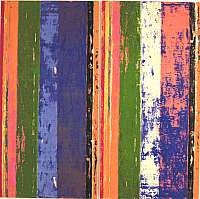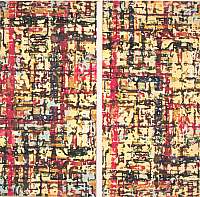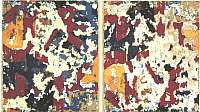This essay appears in English as below and in German translation in the
book, Rainer Gross Twins 1997-98, which has been published
in conjunction with an exhibition of these "Twins"
which was presented from October 30, 1998, until mid-December,
1998, at Galerie Benden und Klimczak, Oberstr. 2, D-41749
Viersen, Germany [Ph.: 49 2162 77059; Fax: 49 2162 81385].
The book, which has many excellent color reproductions, may be
purchased through the gallery.
Rainer Gross
by Fred Camper
Ever since CÚzanne first created an art based on an ongoing
investigation of perception and unresolved tensions between
representation and abstraction, artists have been creating works
that present themselves less as answers than as questions.
Artists from Marcel Duchamp to Jasper Johns have created works
that embody contradiction rather than seek resolution. Three
issues that have long bedeviled twentieth-century art — the
quest for originality, for ideal forms, and for aesthetic beauty
— are presented in Rainer Gross' "Twins" series.
Gross' works are originals and not; they suggest the purity of
geometric abstraction and its opposite; they are visually
seductive, and destructive of seduction. Their extraordinary
power comes in part from their perceptual complexity, in part
from the unanswered and unanswerable inquiries they initiate, but
perhaps most uniquely from the way they express linked themes,
tied together as intimately as the subject and countersubject of
a fugue.
The viewer encountering the "Twins" for the first
time may find them a bit disorienting. In each, two canvasses,
identically sized and with similar designs, are hung side by side
an inch or two apart. Though they appear somehow related, the
designs are not the same; these are not identical twins. Yet
lines and colors echo almost uncannily from one to the next,
repetitions too close for them to be "fraternal" twins
either. If you spend enough time looking, you'll see that if one
panel is rotated 180 degrees, it becomes an approximate mirror
image of the other. But still they will not be exact reflections.
A red square in one will be almost entirely absent from the
other; a blue and lavender area in one will be almost entirely
blue in its counterpart. They seem to have geometrical designs at
their root, mostly of straight lines and rectangles that have
then been somehow distressed. Paint is flaking off everywhere;
thick flakes of one color will be superimposed on another color.
One soon begins to wonder how were they created.
Gross begins with a canvas to which he applies pigment mixed
with water, painting geometrical designs whose hand-limned edges
are not exactly straight. He then applies oil paint —
sometimes a single color; other times a related design — to
a second canvas, pressing them both together while applying
pressure. Some areas of pigment will come off onto the oil,
obscuring it; in other places the oil will cover the pigment.
These transfers occur unevenly, so that an area of peach, for
instance, may become irregularly flecked with blue. A further
complication is that sometimes one side has been painted in
layers. Gross usually hangs them with the pigment half on the
left and the oil half, inverted, on the right.
This flipping is deeply disorienting. When one studies a
painting, one is inclined to search it for meaning. What
knowledge, or what emotion, is conveyed by the adjacent presence
of two differently hued blue stripes? The long history of
abstract art, and of the
rhetoric around it, has taught us that all manner of emotion, or
whole realms of spirituality, may be found in just such a juxtaposition — or, at least, that the painter has intended
to convey such possibilities. Certainly vision orients itself to
particular arrangements of color. But then one looks to, say, the
right-hand portion of Munteanu Twins and finds that two
blue stripes in the left canvas are replaced by a mostly white
one and a peach one that's extensively flecked with blue. Neither
half is more interesting than the other, and one who understands
each as a monoprint of the other one also understands that these
works lie almost exactly between the original/multiple
bifurcation: there can only be two of them, but neither is the
"copy." Both are equals, and seen by themselves are
incomplete.
juxtaposition — or, at least, that the painter has intended
to convey such possibilities. Certainly vision orients itself to
particular arrangements of color. But then one looks to, say, the
right-hand portion of Munteanu Twins and finds that two
blue stripes in the left canvas are replaced by a mostly white
one and a peach one that's extensively flecked with blue. Neither
half is more interesting than the other, and one who understands
each as a monoprint of the other one also understands that these
works lie almost exactly between the original/multiple
bifurcation: there can only be two of them, but neither is the
"copy." Both are equals, and seen by themselves are
incomplete.
Just as significantly, the automatic and partly random nature
of the patterns created in the contact between the two halves
fits within the recent tradition of artists questioning the power
and meaning of their own gestures, doubting their ability to
create original and expressive marks in our image-saturated age.
Gross has removed part of his self from these, and that removal
is also mirrored in the process he uses to select each title. The
names are plucked randomly from a telephone directory, or, as he
puts it: "like a scientist naming a new species". The
implied reference to natural objects is appropriate to his
process, through which the idea of the artist as creator of
essential forms that will express ideal truths of the universe,
in the manner of Malevich and Mondrian and even arguably an
artist such as Sol LeWitt, is replaced by the artist as mediator
between such forms and randomness, between geometry and nature.
One of Gross' smaller works, Danco Twins, has blue and
red bands in both halves; they meet at right angles, set against
a  yellow
ground. Flip one of them in your mind's eye, and the colors
mostly match up, thick blue
yellow
ground. Flip one of them in your mind's eye, and the colors
mostly match up, thick blue  meeting thick blue and patchy red meeting patchy
red. In time, one figures out which color was on which side, and
where colors have come off onto others. These processes occur
with much more variation in the large and complex Cristin
Twins, where both halves appear as giant mottled grids. This
early work in the series was created a bit differently than the
later ones: both the pigments and then the oil paint were laid
down on the left canvas, in different patterns. In the contact
process parts of both layers have transferred to the right,
leaving each half almost equally mottled. The work's dense
details invite close-up inspection, and the viewer
"lives," as it were, in various tiny yet lush flecks of
paint, while also comparing the two halves, which helps one see
the differences between them. In all of the "Twins,"
the comparison process requires the viewer to be actively engaged
not just in sensual eyesight, but in a certain kind of
"conceptual" looking as well, as one imagines the
original orientation in the mind's eye.
meeting thick blue and patchy red meeting patchy
red. In time, one figures out which color was on which side, and
where colors have come off onto others. These processes occur
with much more variation in the large and complex Cristin
Twins, where both halves appear as giant mottled grids. This
early work in the series was created a bit differently than the
later ones: both the pigments and then the oil paint were laid
down on the left canvas, in different patterns. In the contact
process parts of both layers have transferred to the right,
leaving each half almost equally mottled. The work's dense
details invite close-up inspection, and the viewer
"lives," as it were, in various tiny yet lush flecks of
paint, while also comparing the two halves, which helps one see
the differences between them. In all of the "Twins,"
the comparison process requires the viewer to be actively engaged
not just in sensual eyesight, but in a certain kind of
"conceptual" looking as well, as one imagines the
original orientation in the mind's eye.
Minute comparison only heightens one's sense of viewing
decayed versions of rectilinear forms, ruined or transformed as
if by erosion or oxidation. Yet little if any material is
actually lost; paint that has dropped off from one area appears
on the surface of another. Images have disintegrated, but in so
doing have also partially covered others, linking decay and
image-making. The "Twins" are a bit like lusher
imitations of Mondrian that have been exposed to centuries of
transformation, due both to erosion and to the accretion of new
archeological layers.
These are also works that reward the viewer's close
inspection. Gross often lays his rich colors down in contrasting
bands, heightening each hue's sensuality — which, combined
with the dense mottling, encourages one to almost live in the
paint, finding as much truth in the jagged edges of each
peeled-off area as one would find in a great work of geometrical
abstraction. But rather than describing the progress of the mind
toward some ideal perfection, the "Twins" mediate
between ideal shapes and something more chaotic, something beyond
the power of any single human consciousness to control or
encapsulate. Indeed, Gross says that for him part of the
excitement of creating these works is never knowing exactly what
he will get as he pulls the two canvasses apart, however much he
may try to control it. Standing between original and copy,
difference and resemblance, order and chaos, the viewer is also
situated between the Apollonian, structured beauty of
intentionality — whether that of a controlled work of art or
of a manicured picture-window view — and the elemental,
chaotic beauty found in the patterns made by lichen, or the
wearing-away of a wall poster, or the streaks and splotches on
decaying movie film.
Finally, the curious viewer will try to figure out which
portion of paint came from which half; implied in this attempt is
the natural desire to reconstruct the original "ideal"
forms. But this process also gives the "Twins" an
additional conceptual dimension. The viewer who undertakes this
detailed analysis will finally be thinking back to the moment of
the "printing," of contact and  separation, that
cataclysm that rent apart two well-ordered worlds while messily
intermingling them. The right side of Angoma Twins, for
instance, was solid white before contact with its counterpart,
yet the resulting two halves are similar, white oil paint
covering some areas of pigment on the left, just as pigment
covers different areas of oil paint on the right. In those works
in which the color has been layered, there are even points at
which several layers of color have come off at once, leaving a
bright dot on one side and bare canvas on the other.
separation, that
cataclysm that rent apart two well-ordered worlds while messily
intermingling them. The right side of Angoma Twins, for
instance, was solid white before contact with its counterpart,
yet the resulting two halves are similar, white oil paint
covering some areas of pigment on the left, just as pigment
covers different areas of oil paint on the right. In those works
in which the color has been layered, there are even points at
which several layers of color have come off at once, leaving a
bright dot on one side and bare canvas on the other.
In one of the lushest works, Munteanu
Twins, we find white and peach stripes on its right
canvas corresponding to the two blue stripes that occupy much of
the right portion of the left canvas. A tiny, flaked piece of
paint on the left contains both white and peach, the dividing
line in the middle of the flake, a particularly striking
opposition between geometry and jagged edges that encapsulates in
a fraction of an inch much of what these pictures are about. This
also indicates that the white and peach stripes were originally
on the right. The viewer can then see that the blue that covers
much of the lower half of the peach came from the left, and that
in the areas of blue corresponding to solid peach, areas in which
neither color has come completely off, there is a tinge of peach
in the blue.
Trying to figure out what happened, to mentally
restore the lost originals, only heightens one's sense of the way
the imprinting process has irretrievably altered them. There is a
raw and elemental quality to the "Twins" that recalls
natural patterns of decay. It reminds me of one of my own deepest
encounters with nature: a three-hour walk I took, following the
length of the
collapsed Nimitz Freeway in Oakland, California, a
week after the 1989 earthquake. There were still a few unseen
corpses between the crushed concrete, but what amazed me were the
specific ways in which the carefully calculated Euclidean forms
of the freeway — its perfect curves, its plumb-straight
concrete supports — had been transformed into something
else, something full of bends and twists and all manner of
variegated patterns. One can see sights just as profound in every
abandoned parking lot that is being reclaimed by weeds.
© Copyright Fred Camper 1998
Home Film My Art
Art
Other: (Travel, Rants, Obits)
Links About
Contact
 juxtaposition — or, at least, that the painter has intended
to convey such possibilities. Certainly vision orients itself to
particular arrangements of color. But then one looks to, say, the
right-hand portion of Munteanu Twins and finds that two
blue stripes in the left canvas are replaced by a mostly white
one and a peach one that's extensively flecked with blue. Neither
half is more interesting than the other, and one who understands
each as a monoprint of the other one also understands that these
works lie almost exactly between the original/multiple
bifurcation: there can only be two of them, but neither is the
"copy." Both are equals, and seen by themselves are
incomplete.
juxtaposition — or, at least, that the painter has intended
to convey such possibilities. Certainly vision orients itself to
particular arrangements of color. But then one looks to, say, the
right-hand portion of Munteanu Twins and finds that two
blue stripes in the left canvas are replaced by a mostly white
one and a peach one that's extensively flecked with blue. Neither
half is more interesting than the other, and one who understands
each as a monoprint of the other one also understands that these
works lie almost exactly between the original/multiple
bifurcation: there can only be two of them, but neither is the
"copy." Both are equals, and seen by themselves are
incomplete. 

